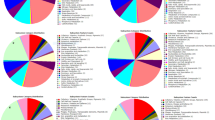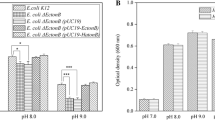Abstract
Several members of the ubiquitously found γ-proteobacterial genus Marinobacter were described or assumed to inhabit marine environments naturally enriched in heavy metals. However, direct studies that describe the ability of this genus to occupy such environments have not been conducted. To cope with heavy metal stress, bacteria possess specific efflux pumps as tools for detoxification, among which the CzcCBA type efflux system is one representative. Previous studies showed that this system plays an important role in resistance towards cadmium, zinc, and cobalt. Up to now, no study had focused on characterization of Czc pumps in Marinobacter sp. or other marine prokaryotes. Herein, we elucidated the function of two CzcCBA pumps encoded by Marinobacter adhaerens HP15’s genome during exposure to cadmium, zinc, and cobalt. Single and double knock-out mutants lacking the corresponding two czcCBA operons were generated and analyzed in terms of their resistance profiles. Both operons appeared to be important for zinc resistance but had no role in tolerance towards cadmium or cobalt. One of the mutations was genetically complemented thereby restoring the wild type phenotype. In accordance with the resistance pattern, expression of the genes coding for both CzcCBA pumps was induced by zinc but neither by cadmium nor cobalt.


Similar content being viewed by others
References
Abou-Shanab RAI, van Berkum P, Angle JS (2007) Heavy metal resistance and genotypic analysis of metal resistance genes in Gram-positive and Gram-negative bacteria present in Ni-rich serpentine soil and in the rhizosphere of Alyssum murale. Chemosphere 68:360–367
Aguilera M, Jimenez-Pranteda ML, Kharroub K, Gonzalez-Paredes A, Durban JJ, Russell NJ, Ramos-Cormenzana A, Monteoliva-Sanchez M (2009) Marinobacter lacisalsi sp. nov., a moderately halophilic bacterium isolated from the saline-wetland wildfowl reserve “Fuente de Piedra” in southern Spain. Int J Syst Evol Microbiol 59:1691–1695
Caille O, Rossier C, Perron K (2007) A copper-activated two-component system interacts with zinc and imipenem resistance in Pseudomonas aeruginosa. J Bacteriol 189:4561–4568
Gaerdes A, Kaeppel E, Shehzad A, Seebah S, Teeling H, Yarza P, Gloeckner FO, Grossart H, Ullrich MS (2010) Complete genome sequence of Marinobacter adhaerens type strain (HP15), a diatom-interacting marine microorganism. Stand Genomic Sci 3:97–107
Gaerdes A, Iversen MH, Grossart H, Passow U, Ullrich MS (2011) Diatom-associated bacteria are required for aggregation of Thalassiosira weissflogii. ISME J 5:436–445
Gaerdes A, Ramaye Y, Grossart H, Passow U, Ullrich MS (2012) Effects of Marinobacter adhaerens HP15 on polymer exudation by Thalassiosira weissflogii at different N: P ratios. Mar Ecol Prog Ser 461:1–14
Gauthier M, Lafay B, Christen R, Fernandez L, Acquaviva M, Bonin P, Bertrand J (1992) Marinobacter hydrocarbonoclasticus gen. nov., sp. nov., a new, extremely halotolerant, hydrocarbon-degrading marine bacterium. Int J Syst Bacteriol 42:568–576
Goldberg M, Pribyl T, Juhnke S, Nies D (1999) Energetics and topology of CzcA, a cation/proton antiporter of the resistance-nodulation-cell division protein family. J Biol Chem 274:26065–26070
Goris J, De Vos P, Coenye T, Hoste B, Janssens D, Brim H, Diels L, Mergeay M, Kersters K, Vandamme P et al (2001) Classification of metal-resistant bacteria from industrial biotopes as Ralstonia campinensis sp. nov., Ralstonia metallidurans sp. nov. and Ralstonia basilensis Steinle et al. 1998 emend. Int J Syst Evol Microbiol 51:1773–1782
Grossart H, Schlingloff A, Bernhard M, Simon M, Brinkhoff T (2004) Antagonistic activity of bacteria isolated from organic aggregates of the German Wadden Sea. FEMS Microbiol Ecol 47:387–396
Handley KM, Lloyd JR (2013) Biogeochemical implications of the ubiquitous colonization of marine habitats and redox gradients by Marinobacter species. Front Microbiol 4:136
Handley KM, Hery M, Lloyd JR (2009) Marinobacter santoriniensis sp. nov., an arsenate-respiring and arsenite-oxidizing bacterium isolated from hydrothermal sediment. Int J Syst Evol Microbiol 59:1850
Hoang T, Karkhoff-Schweizer R, Kutchma A, Schweizer H (1998) A broad-host-range Flp-FRT recombination system for site-specific excision of chromosomally-located DNA sequences: application for isolation of unmarked Pseudomonas aeruginosa mutants. Gene 212:77–86
Intorne AC, de Oliveira MVV, Pereira LdM, de Souza Filho GA (2012) Essential role of the czc determinant for cadmium, cobalt and zinc resistance in Gluconacetobacter diazotrophicus PAI 5. Int Microbiol 15:69–78
Jones P, Binns D, Chang H, Fraser M, Li W, McAnulla C, McWilliam H, Maslen J, Mitchell A, Nuka G, Pesseat S, Quinn AF, Sangrador-Vegas A, Scheremetjew M, Yong S, Lopez R, Hunter S (2014) InterProScan 5: genome-scale protein function classification. Bioinformatics 30:1236–1240
Kaeppel EC, Gaerdes A, Seebah S, Grossart H, Ullrich MS (2012) Marinobacter adhaerens sp. nov., isolated from marine aggregates formed with the diatom Thalassiosira weissflogii. Int J Syst Evol Microbiol 62:124–128
Leedjaerv A, Ivask A, Virta M (2008) Interplay of different transporters in the mediation of divalent heavy metal resistance in Pseudomonas putida KT2440. J Bacteriol 190:2680–2689
Legatzki A, Franke S, Lucke S, Hoffmann T, Anton A, Neumann D, Nies D (2003a) First step towards a quantitative model describing Czc-mediated heavy metal resistance in Ralstonia metallidurans. Biodegradation 14:153–168
Legatzki A, Grass G, Anton A, Rensing C, Nies D (2003b) Interplay of the Czc system and two P-type ATPases in conferring metal resistance to Ralstonia metallidurans. J Bacteriol 185:4354–4361
Lemire JA, Harrison JJ, Turner RJ (2013) Antimicrobial activity of metals: mechanisms, molecular targets and applications. Nat Rev Microbiol 11:371–384
Moraleda-Munoz A, Perez J, Luis Extremera A, Munoz-Dorado J (2010) Differential regulation of six heavy metal efflux systems in the response of Myxococcus xanthus to copper. Appl Environ Microbiol 76:6069–6076
Ng HJ, Lopez-Perez M, Webb HK, Gomez D, Sawabe T, Ryan J, Vyssotski M, Bizet C, Malherbe F, Mikhailov VV, Crawford RJ, Ivanova EP (2014) Marinobacter salarius sp. nov. and Marinobacter similis sp. nov., isolated from sea water. PLoS One 9:e106514. doi:10.1371/journal.pone.0106514
Nies D (1995) The cobalt, zinc, and cadmium efflux system CzcABC from Alcaligenes eutrophus functions as a cation–proton antiporter in Escherichia coli. J Bacteriol 177:2707–2712
Nies D (2003) Efflux-mediated heavy metal resistance in prokaryotes. FEMS Microbiol Rev 27:313–339
Nies D, Nies A, Chu L, Silver S (1989) Expression and nucleotide sequence of a plasmid-determined divalent cation efflux system from Alcaligenes eutrophus. Proc Natl Acad Sci USA 86:7351–7355
Pletzer D, Weingart H (2014) Characterization and regulation of the resistance-nodulation-cell division-type multidrug efflux pumps MdtABC and MdtUVW from the fire blight pathogen Erwinia amylovora. BMC Microbiol 14:185
Rensing C, Pribyl T, Nies D (1997) New functions for the three subunits of the CzcCBA cation-proton antiporter. J Bacteriol 179:6871–6879
Sambrook J, Russel DW (2001) Molecular cloning: a laboratory manual. Cold Spring Harbor Laboratory, New York
Schenk A, Berger M, Keith LM, Bender CL, Muskhelishvili G, Ullrich MS (2006) The algT gene of Pseudomonas syringae pv. glycinea and new insights into the transcriptional organization of the algT-muc gene cluster. J Bacteriol 188:8013–8021
Scherer J, Nies DH (2009) CzcP is a novel efflux system contributing to transition metal resistance in Cupriavidus metallidurans CH34. Mol Microbiol 73:601–621
Singer E, Webb EA, Nelson WC, Heidelberg JF, Ivanova N, Pati A, Edwards KJ (2011) Genomic Potential of Marinobacter aquaeolei, a biogeochemical “opportunitroph”. Appl Environ Microbiol 77:2763–2771
Song L, Ren L, Li X, Yu D, Yu Y, Wang X, Liu G (2013) Complete genome sequence of Marinobacter sp. BSs20148. Genome Announc 1:e00236-13. doi:10.1128/genomeA.00236-13
Sonnenschein EC, Gaerdes A, Seebah S, Torres-Monroy I, Grossart H, Ullrich MS (2011) Development of a genetic system for Marinobacter adhaerens HP15 involved in marine aggregate formation by interacting with diatom cells. J Microbiol Methods 87:176–183
Sonnenschein EC, Syit DA, Grossart H, Ullrich MS (2012) Chemotaxis of Marinobacter adhaerens and its impact on attachment to the diatom Thalassiosira weissflogii. Appl Environ Microbiol 78:6900–6907
Stahler F, Odenbreit S, Haas R, Wilrich J, Van Vliet A, Kusters J, Kist M, Bereswill S (2006) The novel Helicobacter pylori CznABC metal efflux pump is required for cadmium, zinc, and nickel resistance, urease modulation, and gastric colonization. Infect Immun 74:3845–3852
Thoma S, Schobert M (2009) An improved Escherichia coli donor strain for diparental mating. FEMS Microbiol Lett 294:127–132
Tseng T, Gratwick KS, Kollman J, Park D, Nies DH, Goffeau A, Saier MH Jr (1999) The RND permease superfamily: an ancient, ubiquitous and diverse family that includes human disease and development proteins. J Mol Microbiol Biotechnol 1:107–125
van der Lelie D, Schwuchow T, Schwidetzky U, Wuertz S, Baeyens W, Mergeay M, Nies D (1997) Two-component regulatory system involved in transcriptional control of heavy-metal homoeostasis in Alcaligenes eutrophus. Mol Microbiol 23:493–503
Vandamme P, Coenye T (2004) Taxonomy of the genus Cupriavidus: a tale of lost and found. Int J Syst Evol Microbiol 54:2285–2289
Vaneechoutte M, Kampfer P, De Baere T, Falsen E, Verschraegen G et al (2004) Wautersia gen. nov., a novel genus accommodating the phylogenetic lineage including Ralstonia eutropha and related species, and proposal of Ralstonia [Pseudomonas] syzygii (Roberts et al. 1990) comb. nov. Int J Syst Evol Microbiol 54:317–327
Wang H, Li H, Shao Z, Liao S, Johnstone L, Rensing C, Wang G (2012) Genome Sequence of deep-sea manganese-oxidizing bacterium Marinobacter manganoxydans MnI7-9. J Bacteriol 194:899–900
Weber KA, Achenbach LA, Coates JD (2006) Microorganisms pumping iron: anaerobic microbial iron oxidation and reduction. Nat Rev Microbiol 4:752–764
Zhang D, Li H, Xin Y, Chi Z, Zhou P, Yu Y (2008) Marinobacter psychrophilus sp. nov., a psychrophilic bacterium isolated from the Arctic. Int J Syst Evol Microbiol 58:1463–1466
Zumaquero A, Macho AP, Rufian JS, Beuzon CR (2010) Analysis of the role of the type III effector inventory of Pseudomonas syringae pv. phaseolicola 1448a in interaction with the plant. J Bacteriol 192:4474–4488
Acknowledgments
This project was funded by the Helmholtz Graduate School for Polar and Marine Research (POLMAR) and Deutsche Forschungsgemeinschaft (UL 169/6-1). The authors would like to thank Dr. Helge Weingart for excellent technical suggestions on mutant generation and Desalegne Abebew Syit for help with cloning of knock-out plasmids.
Author information
Authors and Affiliations
Corresponding author
Electronic supplementary material
Below is the link to the electronic supplementary material.
Rights and permissions
About this article
Cite this article
Stahl, A., Pletzer, D., Mehmood, A. et al. Marinobacter adhaerens HP15 harbors two CzcCBA efflux pumps involved in zinc detoxification. Antonie van Leeuwenhoek 108, 649–658 (2015). https://doi.org/10.1007/s10482-015-0520-5
Received:
Accepted:
Published:
Issue Date:
DOI: https://doi.org/10.1007/s10482-015-0520-5




